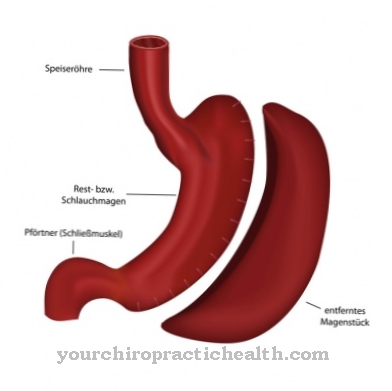At a Mediastinoscopy it is a surgical surgical procedure that is used for diagnosis through a minimally invasive procedure. The aim of this examination is to exclude or detect diseases in the chest area, the mediastinum, and to determine the stage of the disease. It is a procedure for imaging and extracting possible pathological tissue structures.
What is mediastinoscopy?

Mediastinoscopy is an operative imaging and diagnostic procedure. Based on the technology, however, anatomical structures can also be prepared and completely removed, such as individual lymph nodes.
The mediastinum is examined using an endoscope. This is part of the chest and is made up of the windpipe (trachea), esophagus (esophagus), part of the heart and various nerves running there. In addition, lymph nodes and sweetbreads lie in the area of the mediastinum. Bries, also known by the synonym thymus, is an organ of the lymphatic system that is part of the immune system. Today the mediastinoscopy is carried out as a so-called video mediastinoscopy.
By using this technique, the area to be examined can be displayed on a monitor and improves visibility, as individual areas can be enlarged up to 15 times. The anatomical structures of the central posterior mediastinum can thus be viewed much better and more clearly. With classic mediastinoscopy, only the surgeon can see the chest area via the instrument, the mediastinoscope. Those involved in the assistance had no insight into what was happening in the operation.
Function, effect & goals
Mediastinoscopy is almost always carried out for the purpose of diagnosis and is usually not used to treat possible diseases. The aim of mediastinoscopy is to assess a disease, diagnose it and, if necessary, determine its stage and extent. The result of the procedure is of great importance for the further course of the treatment of the patient. Before performing this procedure, preliminary examinations such as magnetic resonance imaging (MRI), computed tomography (CT), positron emission tomography (PET) or a chest x-ray should be performed.
If the previous diagnostic procedures are not informative or if the lymph nodes between the two lungs are enlarged, a mediastinoscopy is necessary.
During a mediastinoscopy, the surgeon can project informative images with an endoscope and take tissue samples. The procedure takes place under a brief general anesthetic. A small incision must be made above the sternum. The mediastinoscope is carefully guided through the incision parallel to the trachea (windpipe) up to the mediastinum. The mediastinoscope is a specially designed instrument, which consists of a small tube with a camera and a suction device. The surgeon and assistants can follow the operation process on the monitor.
The surgeon can get a precise overview and perform a biopsy. To do this, small forceps are inserted into the mediastinum through the tube of the mediastinoscope and small tissue samples are plucked from the affected area. The fine tissue structures removed are presented to the pathologist for examination. With the help of a microscope, he can test the samples taken and make a statement about the type of tumor and the location of the so-called mother's tumor.
This type of diagnosis is used for diseases of the lungs and the mediastinum, such as sarcoid, lung cancer, lymphoma or involvement of the lymph nodes. Furthermore, types of certain infections of the lungs, such as tuberculosis, can be detected or excluded. Basically, this endoscopic diagnosis is necessary if changes in organs in the chest area are present or suspected. Affected areas can be the lungs, the diaphragm, organs of the immune system, trachea and esophagus, and lymph nodes.
You can find accumulations of fluid in the pleura or in the pericardium, which can be watery or purulent, lung tumors (e.g. bronchial carcinoma), sarcoidosis (Boeck's disease or Schaumann-Besnier's disease), a malignant lymphoma or a diffusely growing tumor (mesothelioma). If there is a suspicion based on the symptoms and the previous examination of such a disease, this procedure should be carried out by an experienced specialist.
You can find your medication here
➔ Medication for chest painRisks, side effects & dangers
If a mediastinoscopy is performed professionally and correctly, there are few risks and complications rarely occur. Very rarely, there can be temporary or permanent nerve damage. In individual cases, the organs of the mediastinum can also be injured. This can lead to bleeding, secondary bleeding or sensitivity disorders.
Cardiac arrhythmias and temporary impairment of the vocal cords can also occur as complications. Injuries to the trachea and esophagus have to be sutured, it can lead to leaks. In very rare cases a pneumothorax can occur. A complete follow-up should be carried out after the procedure.
Any side effects such as fever, bleeding from the surgical wound, chest pain or shortness of breath should be reported to the specialist immediately. But also swallowing difficulties, swelling in the throat and hoarseness up to loss of the voice are serious side effects.
Before the operation, drugs that have a negative effect on blood clotting should be discontinued or only taken after consultation with the treating doctor. Taking such drugs increases the risk of profuse bleeding during and after mediastinoscopy. Smoking and the consumption of alcohol before and after the procedure can lead to impaired wound healing.
In order to remedy short and long-term side effects and consequences, physiotherapeutic breathing exercises should be performed postoperatively. The prognosis and the further course of treatment depend on the respective findings made by the mediastinoscopy and will be discussed with the attending physician afterwards.













.jpg)

.jpg)
.jpg)











.jpg)